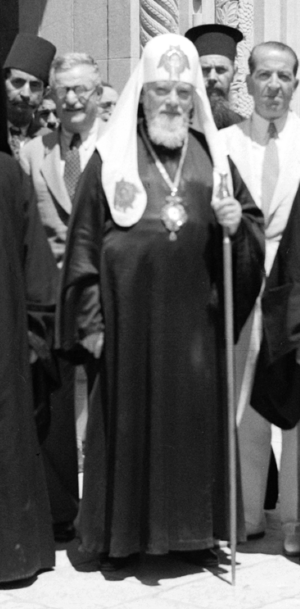Patriarch Alexy I of Moscow facts for kids
Quick facts for kids Alexy I |
|
|---|---|
| Patriarch of Moscow and all the Rus' | |
 |
|
| Church | Russian Orthodox Church |
| See | Moscow |
| Enthroned | 4 February 1945 |
| Reign ended | 17 April 1970 |
| Predecessor | Sergius I |
| Successor | Pimen I |
| Orders | |
| Ordination | 3 January 1904 |
| Consecration | 11 May 1913 by Gregory IV of Antioch |
| Personal details | |
| Birth name | Sergey Vladimirovich Simanskiy |
| Born | November 8, 1877 Moscow, Russian Empire |
| Died | April 17, 1970 (aged 92) Peredelkino, Moscow Oblast, RSFSR, Soviet Union |
| Nationality | |
| Denomination | Eastern Orthodoxy |
| Alma mater | Imperial Moscow University (1899) Moscow Theological Academy |
Patriarch Alexy I (also known as Alexius I, born Sergey Vladimirovich Simansky; November 8, 1877 – April 17, 1970) was a very important leader of the Russian Orthodox Church. He served as the 13th Patriarch of Moscow and all Rus' from 1945 to 1970.
Contents
Early Life and Education
Sergey Vladimirovich Simansky was born in Moscow in 1877. His family was part of the Russian nobility. His father worked for the Russian Imperial Court.
In 1899, Sergey finished his law degree at Moscow Imperial University. After that, he joined the army for a short time.
In 1902, he decided to study at the Moscow Theological Academy. By 1906, he became an archimandrite, which is a high rank for a monk-priest. He was also made the head of a religious school in Tula.
Challenges and Leadership
After the Bolshevik Revolution, the new government was not friendly to religion. Sergey was arrested a few times and sent away to Kazakhstan in 1922.
In 1926, he returned to Saint Petersburg (which was then called Leningrad). He became an Archbishop and helped lead the church in the Diocese of Novgorod.
Working with the Government
In 1927, the head of the Russian Orthodox Church, Metropolitan Sergei Stragorodsky, signed a statement. This statement showed loyalty to the Soviet government. Archbishop Alexy also signed it. This was a difficult time for the Church, and leaders had to find ways to continue their work under strict rules.
For several years, Alexy helped manage the diocese while other church leaders were in prison or exile. In 1933, he became the Metropolitan of Leningrad.
Meeting with Stalin
During World War II, in 1943, Metropolitan Alexy met with Joseph Stalin in the Kremlin. Stalin decided to allow the Russian Orthodox Church to operate more freely. This was a big change after many years of strict rules. Stalin hoped this would encourage Russian people to support the war effort. Many churches were reopened across the Soviet Union.
When Patriarch Sergei died in 1944, Metropolitan Alexy became the temporary head of the Church. He promised Stalin his "profound affection and gratitude." He also vowed to protect the Church.
Becoming Patriarch
On February 2, 1945, with Stalin's approval, Alexius I was chosen as the Patriarch of Moscow and all of Russia. He officially took on this role on February 4, 1945.
In 1946, Patriarch Alexius oversaw a time when the Ukrainian Greek Catholic Church joined the Russian Orthodox Church. Some people felt this was forced by the government. He also encouraged Catholics in the Soviet Union to join the Russian Orthodox Church instead of following the Pope.
Patriarch Alexius joined the World Peace Council in 1949. This group promoted peace, but some believed it was influenced by the Soviet government.
After Stalin's Death
After Stalin died in 1953, Patriarch Alexius sent a message of sadness to the government. He said that Stalin's death was a "heavy grief" for the country and that the Church would always remember his "benevolent attitude."
In 1955, Patriarch Alexius stated that the Russian Orthodox Church supported the Soviet Union's peaceful foreign policy. He said this was because the policy was fair and matched Christian ideals.
However, starting in 1959, the Russian Orthodox Church faced new challenges. The new Soviet leader, Nikita Khrushchev, brought in more rules against religion.
Despite these difficulties, Patriarch Alexius was allowed to have the Russian Orthodox Church join international religious groups. These included the Christian Peace Conference in 1958 and the World Council of Churches in 1961.
Criticism and Later Years
In 1965, two priests, Fathers Gleb Yakunin and Nikolai Eshilman, wrote an open letter to Patriarch Alexius. They said that some church leaders were too quiet or even helped the government close churches and schools. They also criticized how priests were assigned.
This letter was shared secretly through "samizdat" (self-published materials). In 1966, Patriarch Alexius suspended both priests from their duties. Soviet dissident Aleksandr Solzhenitsyn, a famous writer, also criticized this decision in his own letter to the Patriarch.
Patriarch Alexius died in 1970 at the age of 92 from a heart attack. He was buried at the Trinity Lavra of St. Sergius near Moscow.
Legacy and Impact
Many people praise Alexius I for working hard to help Christianity survive in Russia during a very difficult time. They also admire his efforts to promote peace and unity among different churches.
However, some critics, like Father Gleb Yakunin, believed that the church leaders after World War II were too controlled by the KGB (the Soviet secret police). They felt that the Church should have resisted the government more strongly.
See also
 In Spanish: Alejo I de Moscú para niños
In Spanish: Alejo I de Moscú para niños


